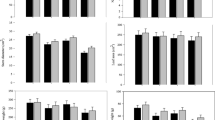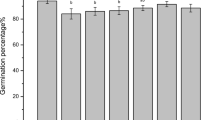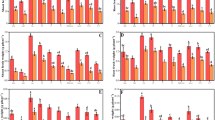Abstract
Agricultural practices and industrial growth have contaminated the environment with heavy metals and many other harmful compounds. Arsenic (As) has been highlighted as a major heavy metal affecting growth and development of plants as well as causing severe human health hazards through food chain contamination. Most studies of heavy metal impacts address only one of these aspects, overlooking the effect of pollution on the plant as a whole. In this work, our objective was to determine the effect of arsenic stress on physiological, biochemical, and morphological characteristics in seedlings of two cultivars of maize with different arsenic tolerance. This study investigated the effects of varying levels of arsenic (As) stress on growth, enzymatic characteristics, and cell ultrastructure in seedlings of As-sensitive and As-tolerant maize cultivars (Shiyu No. 9 and Dongdan90, respectively) grown in hydroponic culture. Compared to Shiyu No. 9 at the same As concentration, Dongdan90 maintained higher values of biomass, shoot length, root length, and activity of superoxide dismutase, peroxidases, and catalase, but had lower malondialdehyde content, As accumulation, and non-protein thiol. High As concentrations inhibited the growth of both cultivars, while lower concentrations stimulated it. The As-tolerant cultivar also maintained the structural integrity of cells and tissues more efficiently under As stress. These findings demonstrate a link between the physiological and physical impacts of heavy metals on crop plants that paves the way for improved interventions to deal with heavy metal pollution.







Similar content being viewed by others
References
Abedin, M. J., Feldmann, J., & Meharg, A. A. (2002). Uptake kinetics of arsenic species in rice plants. PlantPhysiology, 128(3), 1120–1128.
Andre, C. M., Larondelle, Y., & Evers, D. (2010). Dietary antioxidants and oxidative stress from a human and plant perspective: a review. Current Nutrition & Food Science, 6(1), 2–12. doi:10.2174/157340110790909563.
Apel, K., & Hirt, H. (2004). Reactive oxygen species: metabolism, oxidative stress, and signal transduction. Annu Rev. Plant. Biol, 55, 373–399. doi:10.1146/annurev.arplant.55.031903.141701.
Assuncao, A. G. L., Da Costa Martins, P., De Folter, S., et al. (2001). Elevated expression of metal transporter genes in three accessions of the metal hyperaccumulator Thlaspi caerulescens. Plant, Cell and Environment, 24, 217–226. doi:10.1111/j.1365-3040.2001.00666.x.
Bao SD. (2000). Soil agricultural chemistry analysis, third edition. Beijing, China Agriculture Press (in Chinese), 268–270.
Baroni, F., Boscagli, A., Lellaa, L. A. D., et al. (2004). Arsenic in soil and vegetation of contaminated areas in southern Tuscany (Italy). Journal of Geochemical Exploration, 81, 1–14. doi:10.1016/S0375-6742(03)00208-5.
Chaoui, A., Mazhoudi, S., Ghorbal, M. H., et al. (1997). Cadmium and zinc induction of lipid peroxidation and effects on antioxidant enzyme activities in bean (Phaseolus vulgaris L.). Plant Science, 127, 139–147. doi:10.1016/S0168-9452(97)00115-5.
Devi, S. R., & Prasad, M. N. V. (1998). Copper toxicity in Ceratophyllum demersum L. (Coontail), a free-floating macrophyte: response of antioxidant enzymes and antioxidants. Plant Science, 138, 157–165. doi:10.1016/S0168-9452(98)00161-7.
Dhindsa, R. A., Plumb-Dhindsa, P., & Thorpe, T. A. (1981). Leaf senescence: correlated with increased levels of membrane permeability and lipid peroxidation, and decreased levels of superoxide dismutase and catalase. Journal of Experimental Botany, 32, 93–101. doi:10.1093/jxb/32.1.93.
Du, Q. D., Huang, Z. B., Shen, C., et al. (2012). Effect of environmental materials on germination of maize seed under stress of lead, cadmium and arsenic. Journal of Agro-Environment Science, 31(5), 874–879.
Elstner, E. F. (1986). Oxygen activation and oxygen toxicity. Annual Review of Plant Physiology, 33, 73–96. doi:10.1146/annurev.pp.33.060182.000445.
Fisher NS, Jones GJ, Nelson DM (1981). Effect of copper and zinc on growth, morphology and metabolism of Asterionella japonica (Cleve). Exp. Biol. Ecol, 51, 37–56. http://dx.doi.org/10.1016/0022-0981(81)90153-2 http://www.sciencedirect.com/science/article/pii/_blankdoi:10.1016/0022-0981(81)90153-2
Gabrielli, R., Pandolfini, T., Vergano, O., & Palandri, M. R. (1990). Comparison of two serpentine species with different nickel tolerance strategies. Plant and Soil, 122, 671–693. doi:10.1007/BF02851985.
Gao, J. J., Qin, A. G., & Yu, X. C. (2009). Effects of grafting on cucumber leaf SOD and CAT gene expression and activities under low temperature stress. Chinese Journal of Applied Ecology, 20(1), 213–217.
Gu, Z. P., Wang, X., Pan, Y. H., et al. (2010). Effect of arsenic on physiological and biochemical properties of Pteris cretica var. nervosa under two culture conditions. Journal of Agro-Environmental Science, 29(10), 1254–1260.
Guo, X. F., Wei, Z. B., Qu, J. R., et al. (2010). Differences between corn cultivars in accumulation and translocation of heavy metals. Journal of Ecology and Rural Environment, 26(4), 367–371.
Halliwell, B., & Gutteridge, J. M. C. (1989). Free radicals in biology and medicine (2nd ed.). Oxford: Clarendon. doi:10.1080/09553009014552071.
Hasan, S. A., Fariduddin, Q., Ali, B., Hayat, S., & Ahmad, A. (2009). Cadmium: toxicity and tolerance in plants. Environ Biol, 30, 165–174. doi:10.1016/0098-8472(95)00024-0.
He, J., Ma, H. M., & Xie, Y. H. (2014). Influence of Pb and As on growth of Beijing Sweet 183 and Zhengdan 958 corn. Journal of Shanxi Agricultural Sciences, 42(2), 126–128. doi:10.3969/j.issn.1002-2481.2014.02.06.
Hsu, J. M. (1981). Lead toxicity as related to glutathione metabolism. Nutr, 111, 26–33.
Hu, Y. J., Wang, H. J., Wang, H. B., et al. (2015). The relationship between endogenous auxin and antioxidant enzymes in two plants with different arsenic-accumulative ability under arsenic stress. Acta Ecologica Sinica, 35(10), 1–12. doi:10.5846/stxb201312022863.
Huang, H. Y., Xu, J., et al. (2011). Adsorption and enrichment character of heavy metal ions in different plants of polluted and abandoned farmland in Dabaoshan mine area. Guangdong Agricultural Science, 20, 142–144.
Kieffer, P., Planchon, S., Oufir, M., et al. (2009). Combining proteomics and metabolite analyses to unravel cadmium stress-response in poplar leaves. Journal of Proteome Research, 8, 400–417. doi:10.1021/pr800561r.
Laura, M., Gabriella, B., Mohammad, W., & Claudio, B. (2014). Morphological changes induced by heavy metals in dandelion (Taraxacum officinale Web.) growing on mine soils. Journal of Soils and Sediments, 14, 731–743. doi:10.1007/s11368-013-0823-y.
Li, F. Y. (2001). The influences of lead on wheat seedlings’ some physiological characteristics. Henan Science, 19(2), 209–211.
Li KR, Yan BH, Shi YK (2013) Tolerances of tested plants to the heavy metal pollution of coal gangue stack in the south part of Loess Plateau. ACTA AGRESTIA SINICA, 21(6), 1093-1100. doi:10.11733/j.issn.1007-0435.2013.06.009
Li, M., & Wang, G. X. (2002). Effect of drought stress on activities of cell defense enzymes and lipid peroxidation in Glycyrrhiza uralensis seedlings. Acta Ecologica Sinica, 22(4), 503–507.
Liu, W. J., Hu, Y., Bi, S. Q., et al. (2006). Study of genotypic differences on arsenic uptake by and translocation in rice seedlings. Chinese Agricultural Science Bulletin, 22(6), 356–360.
Liu, W. T., Zhou, Q. X., Sun, Y. B., & Liu, R. (2009). Variety difference of lead accumulation and translocation in Chinese cabbage (Brassica peckinensis L.). China Environmental Science, 29(1), 63–67.
Liu, H. L., Hao, Y. B., Ci, X. K., et al. (2010). The response of different genotypic maize to arsenic. Journal of Nuclear Agricultural Sciences, 24(4), 704–712.
Meenakshi, C., Umesh Kumar, J., Mohammed, A. K., et al. (2007). Effect of heavy metal stress on proline, malondialdehyde, and superoxide dismutase activity in the cyanobacterium Spirulina platensis-S5. Ecotoxicology and Environmental Safety, 66, 204–209. doi:10.1016/j.ecoenv.2006.02.002.
Milone, T. M., Sgherri, C., Clijsters, H., & Navari-Izzo, F. (2003). Antioxidative responses of wheat treated with realistic concentration of cadmium. Environmental and Experimental Botany, 50, 265–276. doi:10.1016/S0098-8472(03)00037-6.
Miyake, C., & Asada, K. (1994). Ferredoxin-dependent photoreduction of the monodehydroascorbate radical in spinach thylakoids. Plant Cell Physiology, 35, 539–549.
Motlhanka, D. M. T. (2008). Free radical scavenging activity of selected medicinal plants of Eastern Botswana. Pakistan Journal of Biological Sciences, 11(5), 805–808. doi:10.3923/pjbs.2008.805.808.
Pal, M., Horvath, E., Janda, T., Paldi, E., et al. (2006). Physiological changes and defense mechanisms induced by cadmium stress in maize. Journal of Plant Nutrition and Soil Science, 169, 239–246. doi:10.1002/jpln.200520573.
Pickering, I. J., Prince, R. C., George, M. J., et al. (2000). Reduction and coordination of arsenic in Indian Mustard. Plant Physiology, 122(4), 1171–1177. doi:10.1104/pp.122.4.1171.
Poulter, A., Collin, H. A., Thurman, D. A., et al. (1985). The role of cell wall in the mechanism of lead and zinc tolerance in Anthoxonthum odoratum L. Plant Science, 42, 61–66. doi:10.1016/0168-9452(85)90029-9.
Powell, M. J., Davis, M. S., & Francis, D. (1986). The influence of zinc on the cell cycle in the root meristem of a zinc-tolerant and non tolerant cultivar of Frestuca rubra L. New Phytologist, 102, 419–428. doi:10.1111/j.1469-8137.1986.tb00819.x.
Rama, D. S., & Prasad, M. N. V. (1998). Copper toxicity in Ceratophyllum demersum L. (Coontail), a free floating macrophyte: response of antioxidant enzymes and antioxidant. Plant Science, 138(2), 157–165. doi:10.1016/S0168-9452(98)00161-7.
Ren, A., Gao, Y. B., & Liu, S. (2000). Effects of Cr, Cd and Pb on free proline content etc in leaves of Brassica chinensis L. Chinese Journal of Applied and Environmental Biology, 6(2), 112–116.
Salardini, A. A., Sparrow, L. A., & Holloway, R. J. (1993). Effects of potassium and zinc fertilizers, gypsum and leaching on cadmium in the seed of poppies (Papaver somniferum L.). In N. J. Barrow (Ed.), Plant nutrition from genetic engineering to field practice (pp. 795–798). Dordrecht: Kluwer Academic Publishers. doi:10.1007/978-94-011-1880-4_177.
Shah, K., Kumar, R. G., Verma, S., et al. (2006). Effect of cadmium on lipid peroxidation, superoxide anion generation and activities of antioxidant enzymes in growing rice seedlings. Plant Science, 161, 1135–1144. doi:10.1016/S0168-9452(01)00517-9.
Shi, J., Pan, G. X., & Li, L. Q. (2008). Effects of Cd spiking on cell ultrastructure of root and leaf of two rice cultivars. Asian Journal of Ecotoxicology, 3(4), 403–409.
Siedlecka, A., & Krupa, Z. (2002). Functions of enzymes in heavy metal treated plants. In M. N. V. Prasad & S. Kazimierz (Eds.), Physiology and biochemistry of metal toxicity and tolerance in plants (pp. 314–317). Netherlands: Kluwer. doi:10.1007/978-94-017-2660-3_12.
Siekevitz, P. (1957). Powerhouse of the cell. Scientific American, 197, 131–140.
Sinha, S., Basant, A., Malik, A., & Singh, K. P. (2009). Multivariate modeling of chromium-induced oxidative stress and biochemical changes in plants of Pistia stratiotes L. Ecotoxicology, 8, 555–566. doi:10.1007/s10646-009-0313-6.
Tewari, A., Singh, R., Singh, N. K., & Rai, U. N. (2008). Amelioration of municipal sludge by Pistia stratiotes L.: role of antioxidant enzymes in detoxification of metals. Bioresource Technol, 99, 8715–8721. doi:10.1016/j.biortech.2008.04.018.
Thomas, P., & Juedes, M. J. (1992). Influence of lead on glutathione status of Atlantic croaker tissues. Aquatic Toxicology, 23, 11–30. doi:10.1016/0166-445X(92)90009-C.
Tie, B. Q., Yuan, M., Tang, M. Z., et al. (2007). Effects of single heavy metal pollution on the growth and physiological and biochemical characteristics of Eulaliopsis binata. Chinese Journal Eco-Agriculture, 15(2), 99–103.
Visoottiviseth, P., Franeeseoni, K., & Sridokchan, W. (2002). The potential of Thai indigenous plant species for the phytoremediation of arsenic contaminated land. Environmental Pollution, 118(3), 453–461. doi:10.1016/S0269-7491(01)00293-7.
Visviki, I., & Rachlin, J. W. (1991). The toxic action and interactions of copper and cadmium to the marine alga Dunaliella minuta in both acute the chronic exposure. Arch Environ Contam Toxicol, 2, 271–275. doi:10.1007/BF01055915.
Wang HX (2000) Pollution ecology. Beijing: Higher Education Press, 18–19.
Wang, H. X., Shi, G. X., Xu, Q. S., et al. (2008). Physiological characteristics and ultrastructure of Salvinia natans leaves under Cr6+ stress. Acta Botanica Boreali-Occidentalia Sinica, 28(11), 2244–2250.
Wang, Y. Y., Ren, Y. F., Zhou, G. Q., et al. (2009). Effect of cadmium stress on seedlings growth and physiological characteristics in different rice cultivars. Chinese Agricultural Science Bulletin, 25(24), 450–454.
Wang, F., Ding, S., Zhang, C. H., & Ge, Y. (2010). Non-protein thiols, subcellular and molecular distribution of cadmium in two rice cultivars with different tolerance. Journal of Agro-Environment Science, 29(4), 625–629.
Wu, Y. Y., Chen, S., Zhang, Y. Z., et al. (2009). Effect of heavy metal stress on physiological and biochemical characteristics of five evergreen broad-leaved trees. Journal of Nuclear Agricultural Sciences, 23(5), 843–852.
Xiao, M. X., Lin, W. X., Chen, D. M., et al. (2006). Effects of Cd on the cell membrane lipid peroxidation and activity of protecting enzymes in seedlings of rice with different tolerance to Cd pollutant. Chinese Journal of Eco-Agriculture, 14(4), 256–258.
Xu, Q. S., Shi, G. X., Du, K. H., et al. (2003). Toxic effect of Cd2+ treatment on protective enzyme activity and ultrastructure in leaf cells of Potamogeton crispus. Acta Hydrobiologica sinica, 27(6), 584–588.
Yan, C. G., Hong, Y. T., Fu, S. Z., et al. (1997). Effect of Cd, Pb stress on scavenging system of activated oxygen in leaves of tobacco. Acata Ecologica Sinica, 17(5), 488–492.
Yuan, H. Y., Huang, G., Tong, H. Y., & Huang, S. Z. (2013). The change of non-protein thiol content in roots and leaves of Iris lactea var chinensis under Cd stress. Ecology and Environmental Sciences, 22(7), 1214–1219.
Zahra, N., & Muhammad, A. (2009). Assessment of variation in antioxidative defense system in salt-treated pea (Pisum sativum) cultivars and its putative use as salinity tolerance markers. Journal of Plant Physiology, 166, 1764–1774. doi:10.1016/j.jplph.2009.05.005.
Zhang, Y. X. (1997). Toxicity of heavy metals to Hordeum vulgare. Acta Scientiae Circumstantiae, 17(2), 199–205.
Zhang, F. Q., Wang, Y. S., Lou, Z. P., et al. (2007). Effect of heavy metal stress on antioxidative enzymes and lipid peroxidation in leaves and roots of two mangrove plant seedlings (Kandelia candel and Bruguiera gymnorrhiza). Chemosphere, 67, 44–50. doi:10.1016/j.chemosphere.2006.10.007.
Zheng, X., & Huystee, R. B. (1992). Peroxidase-regulated elongation of segments from peanut hypocotyls. Plant Science, 81, 47–56. doi:10.1016/0168-9452(92)90023-F.
Author information
Authors and Affiliations
Corresponding author
Rights and permissions
About this article
Cite this article
Du, L., Xia, X., Lan, X. et al. Influence of Arsenic Stress on Physiological, Biochemical, and Morphological Characteristics in Seedlings of Two Cultivars of Maize (Zea mays L.). Water Air Soil Pollut 228, 55 (2017). https://doi.org/10.1007/s11270-016-3231-2
Received:
Accepted:
Published:
DOI: https://doi.org/10.1007/s11270-016-3231-2




